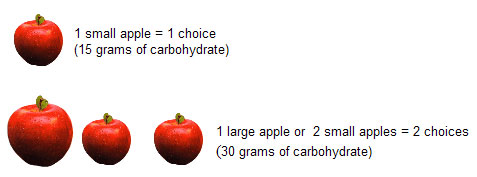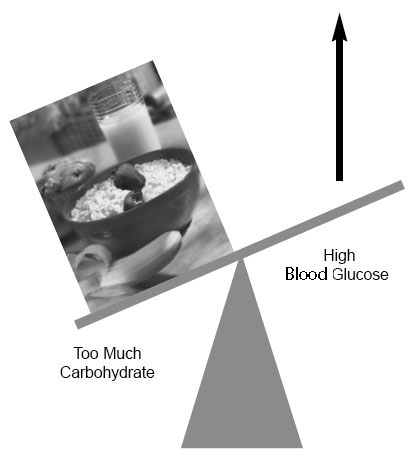Bulletin #4369, Diabetes, Carbohydrates and You: Paying Attention to Carbohydrate
The Diabetes, Carbohydrates and You fact sheet series was developed by the UMaine Cooperative Extension Diabetes Education Committee, including Nellie Hedstrom, nutrition specialist, UMaine Cooperative Extension; Patricia Pierson, Extension educator, UMaine Cooperative Extension; Susan Henner, Extension nutrition aide, UMaine Cooperative Extension; Cheryl Paul, Extension nutrition aide, UMaine Cooperative Extension; Lucinda Hale, Diabetes Prevention & Control Program, Maine Department of Human Services.
For information about UMaine Extension programs and resources, visit extension.umaine.edu.
Find more of our publications and books at extension.umaine.edu/publications/.
What is carbohydrate?
Carbohydrate foods are sugars and starches. Sugars and starches are in
- milk, yogurt, and milk products;
- grains and grain products (bread, rice, noodles, pasta, cereal);
- vegetables, dried beans, dried peas;
- fruits and fruit juice;
- sugar, honey, corn syrup and molasses;
- sweetened foods such as desserts.
People with diabetes need to pay attention to all foods that contain carbohydrates, not just high-sugar foods.
What do carbohydrates do in the body?
Carbohydrates give you energy to use, or to be stored to use later. Most carbohydrate foods have health-giving vitamins and minerals.
Why should people with diabetes be concerned about carbohydrate?
Insulin moves sugar from the blood into your cells, for the body to use for energy. When you have diabetes, your body does not make enough insulin or cannot use the insulin your body makes. Without insulin to move sugar into your cells for energy, sugar stays in your blood. This is called “high blood sugar.”
How long does it take for a food to change to sugar in the blood?
Carbohydrate food: most is changed to sugar within 1 1/2 hours after eating.
Protein food: half is changed to sugar within 3-4 hours after eating.
Fatty food: a small amount is changed to sugar within several hours after eating.
As you can see, carbohydrate foods make your blood sugar level go up the fastest. To control your blood sugar, keep track of the number of carbohydrate choices in your meals and snacks. Use your meal pattern that your health care provider or dietitian gave you to plan meals that give you a variety of foods.
Keep your blood sugar in a healthy range.
To manage your disease,
- plan meals and snacks to include the number of carbohydrate choices in your meal pattern;
- eat meals and snacks at about the same time each day.
What is a carbohydrate choice?
One carbohydrate choice is a serving of food that contains about 15 grams of carbohydrate. Your food plan tells you how many choices you have for each meal. You decide which carbohydrate foods you want to eat.
To count carbohydrates, you need to know the amount of food that makes a serving, and the amount of carbohydrate in the food. If you eat double the serving size, you need to count two carbohydrate choices.
 Example: One carbohydrate choice (15 grams of carbohydrate) equals
Example: One carbohydrate choice (15 grams of carbohydrate) equals
- one serving of grains, beans or starchy vegetables, or
- one serving of milk, or
- three servings of non-starchy vegetable, or
- other carbohydrates in amount listed in the table.
Carbohydrate counting:
Eating too much food at one time can raise blood sugar levels too high. This can be dangerous. Carbohydrate counting helps you keep track of how much carbohydrate you eat for meals and snacks. Skipping meals can cause blood sugar to drop too low. This will make you feel weak, tired and hungry, and you may eat too much at your next meal.
Carbohydrate counting helps you keep track of how much carbohydrate you eat for meals and snacks. It’s best to eat small amounts of carbohydrates at different times during the day, rather than a lot at one time. This helps control your blood sugar levels. (The Basics of Diabetes, International Diabetes Association)
Stay healthy by controlling your blood sugar.
You may have high blood sugar and still feel fine. Or, you may not feel so well. You may feel tired and have no energy. You may urinate often and feel thirsty.
If your blood sugar level stays high, so does your risk of heart attack and stroke. High blood sugar can damage kidneys, nerves, blood vessels, nerves and eyes.
Healthy meals include foods that contain a balance of carbohydrate, protein, and fat. Carbohydrate affects blood sugar levels more than protein and fat. People with diabetes should carefully control the amount of carbohydrate they eat.
Each item below is one carbohydrate choice (15 grams of carbohydrate) |
|
|---|---|
Grains, beans and starchy vegetables
Fruits
Milk
|
Other carbohydrates
Vegetables
|
Information in this publication is provided purely for educational purposes. No responsibility is assumed for any problems associated with the use of products or services mentioned. No endorsement of products or companies is intended, nor is criticism of unnamed products or companies implied.
© 2002, 2009
Call 800.287.0274 (in Maine), or 207.581.3188, for information on publications and program offerings from University of Maine Cooperative Extension, or visit extension.umaine.edu.
The University of Maine is an EEO/AA employer, and does not discriminate on the grounds of race, color, religion, sex, sexual orientation, transgender status, gender expression, national origin, citizenship status, age, disability, genetic information or veteran’s status in employment, education, and all other programs and activities. The following person has been designated to handle inquiries regarding non-discrimination policies: Director of Equal Opportunity, 101 Boudreau Hall, University of Maine, Orono, ME 04469-5754, 207.581.1226, TTY 711 (Maine Relay System).


